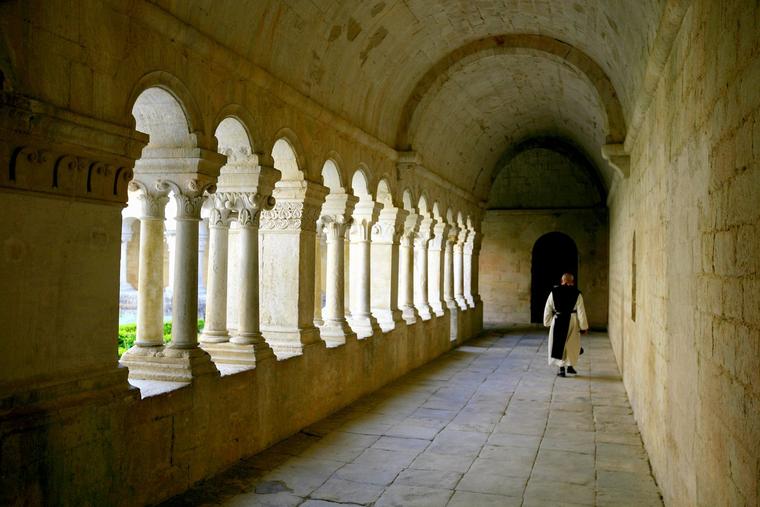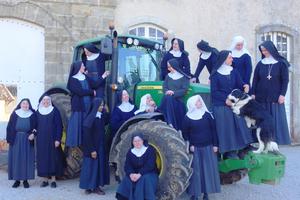The Secret Catholic Code of Cistercian Numerals
This ingenious notation system was introduced by John of Basingstoke, archdeacon of Leicester, in the 13th century.

Here’s something Sr. Mary Agatha, your 8th-grade math teacher, never taught you.
Before Hindu-Arabic numerals were widespread throughout Christendom, the Cistercian monks throughout Europe in the Middle Ages used an alien-looking single and unique, condensed, alphanumerical numerical system that allowed its users to count from 0 to 9999 and beyond. They are more compact than Arabic or Roman numerals, and a single glyph can indicate any integer from 1 to 9,999.
Before the Arabic system became de rigueur in the West, everyone used Roman numerals. This was used throughout Europe and Western Asia for 300 years. The medieval Cistercian monks — a stricter form of the Benedictines — needed a simpler system for simple numbering purposes. Thus, from the 13th to 15th centuries, European monks developed Cistercian numerals. Similar to Chinese ideograms — a succinct, single alphanumeric symbol that symbolizes all of the 0-9 digits:

The numeral system was introduced by John of Basingstoke, archdeacon of Leicester, in the 13th century. The system is based on the ancient Greek numerical system. John of Basingstoke was a Greek scholar and keen to spread Greek scholarship among his monks.
He originally intended for it to represent numbers from 1 to 99 but it quickly expanded to accommodate numbers up to 9,999. Zero is depicted as merely a plain stave.
This system was in effect in Cistercian monasteries from the 13th to the 15th century throughout all of Europe, from Portugal to Poland and from Italy to Sweden.
These numerals can’t easily be used for mathematical calculations. Instead, they were used for dates, to number pages in manuscripts, divisions of texts, the numbering of notes, lists, indexes and concordances, for parcels meant for delivery, musical notation, and even for calculations for Easter Sunday. The system was also brought in for notations involving agriculture and hydraulic engineering — a Cistercian specialty. The glyphs were even used to number wine barrels and to gauge the wine in those barrels even until the 18th century, and there are 14th-century astrolabes that use the Cistercian numerals to measure heights, distances and determine direction.
Each symbol is based on the Christian cross — having four quadrants — and any number can be depicted to make a unique, easily read cipher. Here are the four quadrants:

Each symbol can represent any 1-4 digit number. To use this system, the individual will need to memorize only nine easy symbols:
- If an element of the cipher appears in the ONES quadrant, then it symbolizes 1-9.
- If an element of the cipher appears in the TENS quadrant, then it symbolizes 10-90.
- If an element of the cipher appears in the HUNDREDS quadrant, then it symbolizes 100-900.
- If an element of the cipher appears in the THOUSANDS quadrant, then it symbolizes 1000-9000.
Digits are based on a stave, with the position of the digit on the stave indicating its place value (ones, tens, hundreds or thousands). These digits are compounded on a single stave to indicate more complex numbers. By assigning these ticks in the correct quadrant, any number can be depicted:

Several admirable attempts have been made over the centuries to expand this system to allow it to depict millions, billions and trillions.
Numbers in between are simply overlaid onto the same cipher:

All of the symbols are formed by using a single stave — at first, they were horizontal and later, in the 14th and 15th centuries, vertical. Here are the horizontal staves:

Since these staves look like Christ’s cross, the Cistercian numerals act as a metaphor for the Savior, making the system a profound Catholic Christian symbol.
Even if you were not to have fun with these numerals, it’s a wonder of the beauty of Catholicism to think that even our numbers and mathematics reflect the glory that is God.
Unprecedented Catholic Fun:
- You can download the font here to have fun on your computer: https://github.com/ctrlcctrlv/FRBCistercian/raw/main/dist/FRBCistercian.otf
- Using this link to download an app onto your Apple device to help you understand this amazing system: https://apps.apple.com/us/app/cistercian-numerals/id1594907571
- Here’s a fun Cistercian number generator: https://www.dcode.fr/cistercian-numbers
- Here are all of the Cistercian numbers from 1-9999: https://scipython.com/static/media/uploads/blog/cistercian-numerals/all_cistercian_numeral
- And if you have an Apple Watch, you can download your own Cistercian watch face: https://getwatchmaker.com/watchface/cistercian-clock
- Here’s the pièce de résistance — instructions on how you and your kids can make a digital Cistercian display clock: https://www.instructables.com/Cistercian-Digital-Clock/
- And if you’ve still not had your fill of Catholic geekery, consider learning how to code a Cistercian clock: https://www.hsablonniere.com/a-clock-based-on-cistercian-numerals--hptit8/
- Keywords:
- cistercians
- middle ages
- mathematics

















